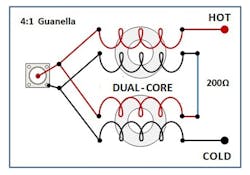Basic Baluns
The type of balun used in microwave RF designs depends on the bandwidth required, the operating frequency, and the physical architecture of the design. As differential power dividers, baluns can be transformers, capacitively and/or magnetically coupled transmission lines, hybrid couplers, or used in a combination of power divider and inverter. Baluns are used in many applications from creating transitions between single ended and differential signals and in canceling mode noise and signals. The baluns most important property is in power balance and phase balance.
The flux coupled balun transformer is the most common type of balun which is basically two separate wires wound around a magnetic core with one side of the primary winding grounded thus creating an unbalanced condition on the primary side and a balanced condition on the secondary side. The secondary side can have an arbitrary ratio of turns to the primary side creating the arbitrary impedance ratio. The flux coupled balun transformer will induce an AC voltage in the secondary of n times the voltage in the primary, while the current will be n times smaller than in the primary, giving an output impedance of n2 as stated above, where n is the ratio of turns in the secondary to turns in the primary.
Wire wound flux coupled transformers often have a center tap in the secondary winding with a ground – connecting this point to the ground of the secondary system can improve the balance of the output.
For example, a flux coupled transformer is best suited to frequencies below 1 GHz but often experiences coupling loss at higher frequencies; magnetic materials have a large loss tangent which leads to high signal losses at microwave frequencies. Thus, the capacitive coupled transmission line balun, most often with a bifilar transmission line wrapped around a magnetic core, solves the high frequency problem with the low frequency magnetic coupling and the high frequency capacitive coupling as seen in the Guanella balun.
A balun that is often used in microwave applications is the Marchand balun. The video, Types of Spiral Baluns describes spiral baluns, Interwound, Symmetrical, and Marchand, and the design and simulation of GaAs MMIC planar spiral balun.
Classical Transformer Balun
In classical transformers, or isolation transformers, there are two separate windings of wire coils around the transformer core which can be empty or air, a magnetically neutral material like porcelain, or a magnetic conductor, or soft iron. The primary winding receives the input signal and the secondary winding sends out the converted signal. For ideal transformers, although the ratio of voltage to current will change in exact proportion to the square of the winding ratio, the power, measured in watts, remains identical.
Advantage: electrically separate windings for input and output allow these baluns to connect circuits whose ground-level voltages are subject to ground loops or are electrically incompatible.
Autotransformer or Voltage Balun
An autotransformer balun has one coil or two or more coils that have an electrical connection also wound on a ferrite rod or toroid. A single winding must have at least one extra electrical connection, or tap point, between the ends of the winding. The current sent into the balun through one pair of connections acts as a primary coil and magnetizes the core.
Advantage: unlike transformer-type baluns, an autotransformer balun provides a path for DC current to ground from every terminal.
Transmission-line Transformer or Choke Balun
Sometimes called a current balun, this type of balun ensures equal current on both sides of its output, but not necessarily equal voltage. The currents inside coax are equal and opposite so the magnetic fields are also equal, opposite, and mostly cancel. When a transformer balun is combined with the transmission-line transformer balun, the resulting device has very wideband operation. The Guanella transmission-line transformer is often combined with a balun to act as an impedance matching transformer.
Advantage: the choke balun prevents extra current flowing back along the transmission through inductive impedance.
Delay-line Balun
Using connected transmission lines of specific lengths with no transformer element, these delay-line baluns are usually built for narrow frequency ranges where the connected transmission line lengths are a multiple of a quarter wavelength of the intended frequency in the transmission line medium as seen in a coaxial connection to a balanced antenna.
Advantage: causes 180° phase shift and provides a balanced input.
Self-resonance Balun
Transformers made of real materials have a small capacitance between the primary and secondary windings, as well as between individual loops in any single winding, forming unwanted self-capacitance or parasitic capacitance. When the electrical reactance of the self-inductance and self-capacitance in the balun are equal and opposite, resonance occurs. A balun of any design type operates poorly at frequencies at or above its resonance. Design considerations for baluns are for the purpose of making the resonant frequency as far above the operating frequency as possible. As frequencies rise, the impedance of the parasitic capacitance drops until it’s magnitude equals that of the ideal inductance known as Self Resonant Frequency (SRF).
The inductance acts like an inductor up to its SRF then the impedance becomes very high and the inductor can be used as a choke to attenuate signals near the SRF.
To learn more about Pasternack’s line of baluns, visit: https://www.pasternack.com/nsearch.aspx?Category=Baluns&sort=y&view_type=grid

